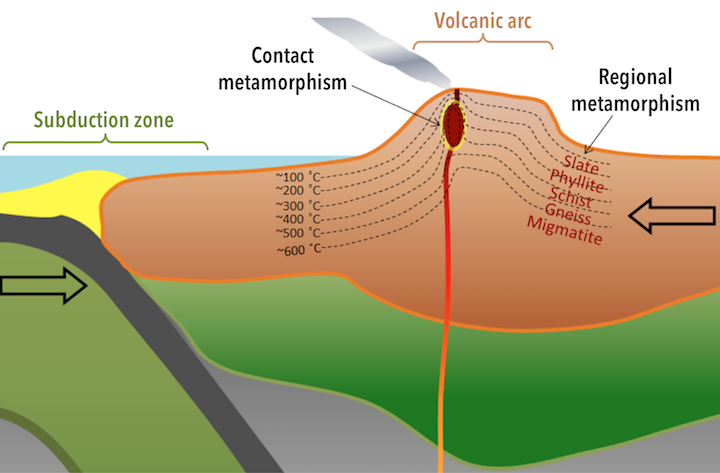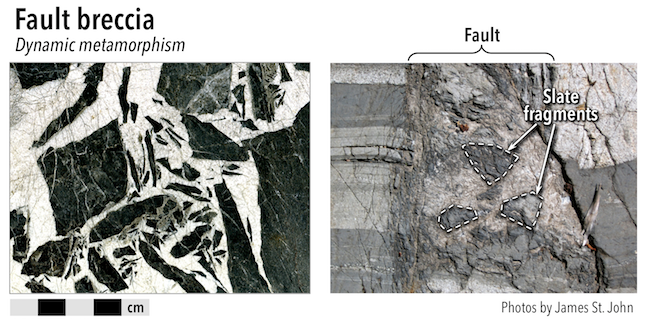6.4 Types of Metamorphism and Where They Occur
The outcome of metamorphism depends on pressure, temperature, and the abundance of fluid involved, and there are many settings with unique combinations of these factors. Some types of metamorphism are characteristic of specific plate tectonic settings, but others are not.
Burial Metamorphism
Burial metamorphism occurs when sediments are buried deeply enough that the heat and pressure cause minerals to begin to recrystallize and new minerals to grow, but does not leave the rock with a foliated appearance. As metamorphic processes go, burial metamorphism takes place at relatively low temperatures (up to ~300 °C) and pressures (100s of m depth). To the unaided eye, metamorphic changes may not be apparent at all. Contrast the rock known commercially as Black Marinace Gold Granite (Figure 6.24)—but which is in fact a metaconglomerate—with the metaconglomerate in Figure 6.10. The metaconglomerate formed through burial metamorphism does not display any of the foliation that has developed in the metaconglomerate in Figure 6.10.

A Note About Commercial Rock Names
Names given to rocks that are sold as building materials, especially for countertops, may not reflect the actual rock type. It is common to use the terms granite and marble to describe rocks that are neither. While these terms might not provide accurate information about the rock type, they generally do distinguish natural rock from synthetic materials. An example of a synthetic material is the one referred to as quartz, which includes ground-up quartz crystals as well as resin. If you happen to be in the market for stone countertops and are concerned about getting a natural product, it is best to ask lots of questions.
Regional Metamorphism
Regional metamorphism refers to large-scale metamorphism, such as what happens to continental crust along convergent tectonic margins (where plates collide). The collisions result in the formation of long mountain ranges, like those along the western coast of North America. The force of the collision causes rocks to be folded, broken, and stacked on each other, so not only is there the squeezing force from the collision, but from the weight of stacked rocks. The deeper rocks are within the stack, the higher the pressures and temperatures, and the higher the grade of metamorphism that occurs. Rocks that form from regional metamorphism are likely to be foliated because of the strong directional pressure of converging plates.
The Himalaya range is an example of where regional metamorphism is happening because two continents are colliding (Figure 6.25). Sedimentary rocks have been both thrust up to great heights—nearly 9 km above sea level—and also buried to great depths. Considering that the normal geothermal gradient (the rate of increase in temperature with depth) is around 30°C per kilometer in the crust, rock buried to 9 km below sea level in this situation could be close to 18 km below the surface of the ground, and it is reasonable to expect temperatures up to 500°C. Notice the sequence of rocks that from, beginning with slate higher up where pressures and temperatures are lower, and ending in migmatite at the bottom where temperatures are so high that some of the minerals start to melt. These rocks are all foliated because of the strong compressing force of the converging plates.

Seafloor (Hydrothermal) Metamorphism
At an oceanic spreading ridge, recently formed oceanic crust of gabbro and basalt is slowly moving away from the plate boundary (Figure 6.26). Water within the crust is forced to rise in the area close to the source of volcanic heat, drawing in more water from further away. This eventually creates a convective system where cold seawater is drawn into the crust, heated to 200 °C to 300 °C as it passes through the crust, and then released again onto the seafloor near the ridge.

The passage of this water through the oceanic crust at these temperatures promotes metamorphic reactions that change the original olivine and pyroxene minerals in the rock to chlorite ((Mg5Al)(AlSi3)O10(OH)8) and serpentine ((Mg, Fe)3Si2O5(OH)4). Chlorite and serpentine are both hydrated minerals, containing water in the form of OH in their crystal structures. When metamorphosed ocean crust is later subducted, the chlorite and serpentine are converted into new non-hydrous minerals (e.g., garnet and pyroxene) and the water that is released migrates into the overlying mantle, where it contributes to melting.
The low-grade metamorphism occurring at these relatively low pressures and temperatures can turn mafic igneous rocks in ocean crust into greenstone (Figure 6.27), a non-foliated metamorphic rock.

Subduction Zone Metamorphism
At subduction zones, where ocean lithosphere is forced down into the hot mantle, there is a unique combination of relatively low temperatures and very high pressures. The high pressures are to be expected, given the force of collision between tectonic plates, and the increasing lithostatic pressure as the subducting slab is forced deeper and deeper into the mantle. The lower temperatures exist because even though the mantle is very hot, ocean lithosphere is relatively cool, and a poor conductor of heat. That means it will take a long time to heat up, can be several hundreds of degrees cooler than the surrounding mantle. In Figure 6.28, notice that the isotherms (lines of equal temperature, dashed lines) plunge deep into the mantle along with the subducting slab, showing that regions of relatively low temperature exist deeper in the mantle.

A special type of metamorphism takes place under these very high-pressure but relatively low-temperature conditions, producing an amphibole mineral known as glaucophane (Na2(Mg3Al2)Si8O22(OH)2). Glaucophane is blue, and the major component of a rock known as blueschist. If you have never seen or even heard of blueschist, that not surprising. What is surprising is that anyone has seen it! Most of the blueschist that forms in subduction zones continues to be subducted. It turns into eclogite at about 35 km depth, and then eventually sinks deep into the mantle, never to be seen again. In only a few places in the world, the subduction process was interrupted, and partially subducted blueschist returned to the surface. One such place is the area around San Francisco. The blueschist at this location is part of a set of rocks known as the Franciscan Complex (Figure 6.29).

Contact Metamorphism
Contact metamorphism happens when a body of magma intrudes into the upper part of the crust. Heat is important in contact metamorphism, but pressure is not a key factor, so contact metamorphism produces non-foliated metamorphic rocks such as hornfels, marble, and quartzite.
Any type of magma body can lead to contact metamorphism, from a thin dyke to a large stock. The type and intensity of the metamorphism, and width of the metamorphic aureole that develops around the magma body, will depend on a number of factors, including the type of country rock, the temperature of the intruding body, the size of the body, and the volatile compounds within the body (Figure 6.30). A large intrusion will contain more thermal energy and will cool much more slowly than a small one, and therefore will provide a longer time and more heat for metamorphism. This will allow the heat to extend farther into the country rock, creating a larger aureole. Volatiles may exsolve from the intruding melt and travel into the country rock, facilitating heating and carrying chemical constituents from the melt into the rock. Thus, aureoles that form around “wet” intrusions tend to be larger than those forming around their dry counterparts.

Contact metamorphic aureoles are typically quite small, from just a few centimeters around small dykes and sills, to as much as 100 m around a large stock. Contact metamorphism can take place over a wide range of temperatures—from around 300 °C to over 800 °C. Different minerals will form depending on the exact temperature and the nature of the country rock.
Although bodies of magma can form in a variety of settings, one place magma is produced in abundance, and where contact metamorphism can take place, is along convergent boundaries with subduction zones, where volcanic arcs form (Figure 6.31). Regional metamorphism also takes place in this setting, and because of the extra heat associated with the magmatic activity, the geothermal gradient is typically steeper in these settings (between ~40 and 50 °C/km). Under these conditions, higher grades of metamorphism can take place closer to surface than is the case in other areas.

Shock Metamorphism
When extraterrestrial objects hit Earth, the result is a shock wave. Where the object hits, pressures and temperatures become very high in a fraction of a second. A “gentle” impact can hit with 40 GPa and raise temperatures up to 500 °C. Pressures in the lower mantle start at 24 GPa (GigaPascals), and climb to 136 GPa at the core-mantle boundary, so the impact is like plunging the rock deep into the mantle and releasing it again within seconds. The sudden change associated with shock metamorphism makes it very different from other types of metamorphism that can develop over hundreds of millions of years, starting and stopping as tectonic conditions change.
Two features of shock metamorphism are shocked quartz, and shatter cones. Shocked quartz (Figure 6.32 left) refers to quartz crystals that display damage in the form of parallel lines throughout a crystal. The quartz crystal in Figure 6.32 has two sets of these lines. The lines are small amounts of glassy material within the quartz, formed from almost instantaneous melting and resolidification when the crystal was hit by a shock wave. Shatter cones are cone-shaped fractures within the rocks, also the result of a shock wave (Figure 6.32 right). The fractures are nested together like a stack of ice-cream cones.

Dynamic Metamorphism
Dynamic metamorphism is the result of very high shear stress, such as occurs along fault zones. Dynamic metamorphism occurs at relatively low temperatures compared to other types of metamorphism, and consists predominantly of the physical changes that happen to a rock experiencing shear stress. It affects a narrow region near the fault, and rocks nearby may appear unaffected.
At lower pressures and temperatures, dynamic metamorphism will have the effect of breaking and grinding rock, creating cataclastic rocks such as fault breccia (Figure 6.33). At higher pressures and temperatures, grains and crystals in the rock may deform without breaking into pieces (Figure 6.34, left). The outcome of prolonged dynamic metamorphism under these conditions is a rock called mylonite, in which crystals have been stretched into thin ribbons (Figure 6.34, right).


References
Bucher, K., & Grapes, R. (2011) Petrogenesis of Metamorphic Rocks, 8th Edition. Springer.
French, B.M. (1998). Traces of Catastrophe: A Handbook of Shock-Metamorphic Effects in Terrestrial Meteorite Impact Structures. Houston, TX: Lunar and Planetary Institute Read full text
Licenses and Attributions
“Physical Geology, First University of Saskatchewan Edition” by Karla Panchuk is licensed under CC BY-NC-SA 4.0 Adaptation: Renumbering, Remixing

